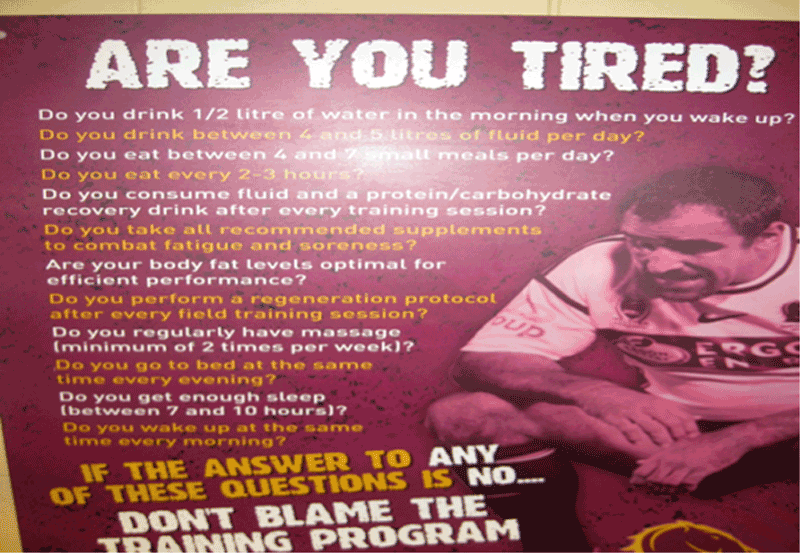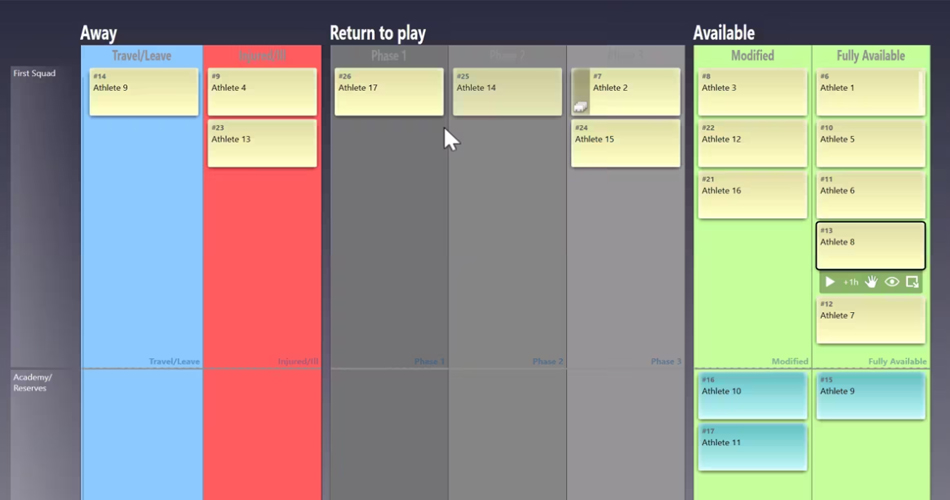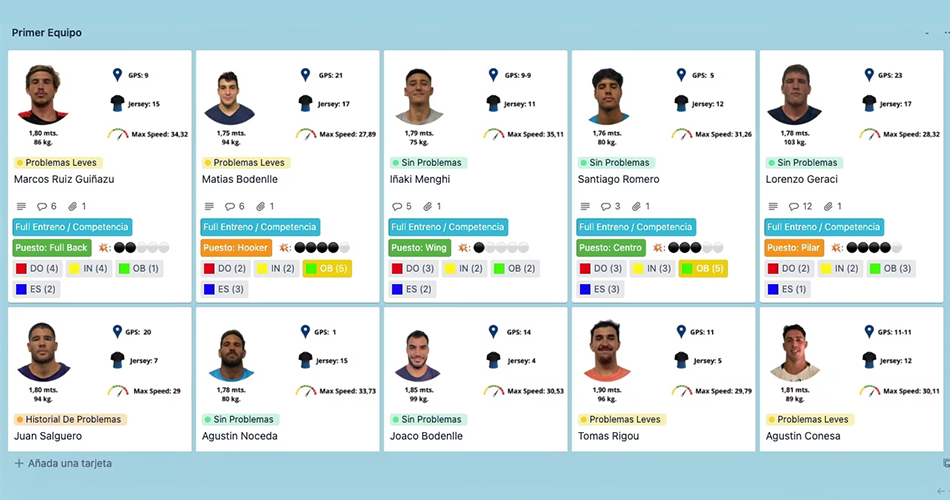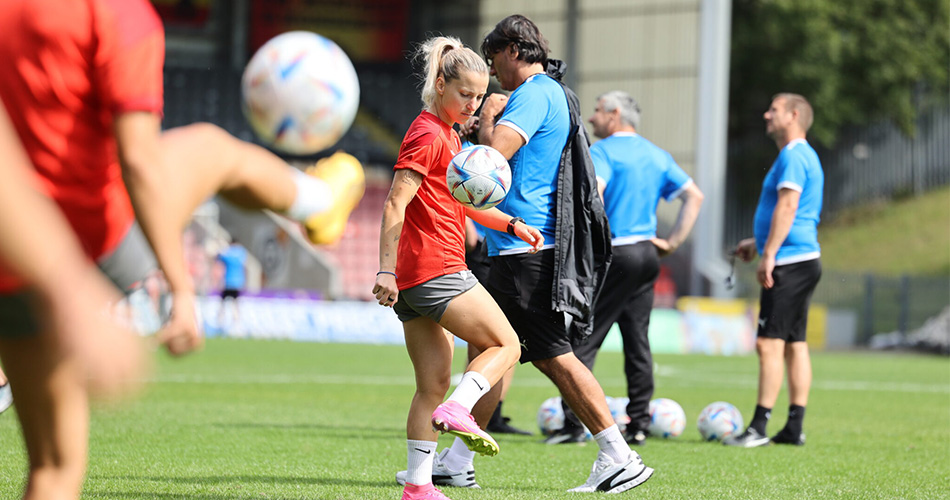Random Thoughts
I have couple of topics/thoughts to cover, but they are not major enough to deserve their own blog post, so I decided to put them altogether in one Random Thoughts post.
RTP as Project Management
I’ve read short and sharp article from Dr. Boris Gojanovic et al. on the topic of using project management principles in return to play (RTP) [BJSM]. It is very much along the lines of “my solution” outlined in THIS video.
Dr. Boris Gojanovic et al. outlined simple dashboard (information radiator; visual management) that could be used to put performance staff on the same page and provide more transparency and agility of the RTP process.
Monitoring and visualising weekly RTP progression

Figure 2 Monitoring RTP progression. This document is a work in progress that is being updated on a daily basis if needed, but at least once a week for each member of the team. It allows each person to check on the progression and communication with the whole team at a glance, and sets the flow of information through a case manager, who can be any team member (not necessarily the physiotherapist or physician). All goals are tracked and responsibilities attributed from the start of the RTP project. Deadlines for reviews and meetings are listed and updated. The information can be visually shared with the athlete at any time point to help with decision-making. MOOC, massive open on-line course; PT, personal training; RSI, relative strength index; RTP, return to play; S&C coach, strength and conditioning coach
I am more than glad to see other’s finding much utility of Agile (and PM) in managing performance programs and staff.
When it comes to visual management (Kanban), besides Trello, Eylean, LeanKit, I’ve found the following products very interesting and they could be used in managing high-performance staff and processes:
The next app is useful in creating a “roadmaps” (e.g. plans):
Daily Self-Monitoring With “Active” Questions
I just finished listening to The Triggers: Creating Behavior That Lasts by Marshall Goldsmith, and while not much different than other behavior/habits changing books (Switch, The Power of Habit, Influencer) it provided one simple idea that I’ve picked up as useful: daily self-monitoring with “active” questions.
As me and Mike Boyle concluded in the recent podcast, we are into habit/culture changes business. We want to make our athletes better players and better people. This is a tough process and not everyone is eager/able to change their/our habits or culture for their/our benefit. We need to become influencers – as Carl Valle used to say “It is not what you know, it is what you make your athletes do”.
Teams tend to monitor players’ wellness and RPEs and adjust the training based on their “readiness”. But before they implement strategies such as those, I advise coaches to make sure the culture in the team is right and that the “elephants in the room” are addressed. In the quite popular article I wrote Shopping List: Technology, I’ve mentioned that interventions are more important than monitoring. One does not need any fancy monitoring to address the crucial (vital) habits and behaviors. When this is addressed (“elephants in the room”), then we can start worrying about other things.
Dan Baker had awesome poster regarding this very issues that was posted in Brisbane Broncos training ground:

So what does The Triggers: Creating Behavior That Lasts by Marshall Goldsmith have to do with this? His idea of using “active” questions could be utilized here.
For example, if we are into behavioral change, rather than touchy-feely modifications of training loads based on wimpy athletes, we might form two different questions in our wellness questionnaires:
- How recovered do you feel? [1-10] (Passive)
- Did you do your best to recover between training sessions [1-10] (Active)
So, in my opinion the wellness questionnaires can have two-fold purpose: the first one could be monitoring subjective ratings, and the second one could be influencing behavioral change. Again, it all depends on the culture at hand and objectives of the staff. If you ask me, I would rather start with “active” questions and aim to establish responsible culture in the team FIRST, and then later worry how the athletes feel. Intervention > Monitoring.
Once we have this culture working, where the athletes are responsible and doing their best to be 24/7 athletes, then we can start worrying about their subjective ratings. This is the elephant in the room usually overseen by the staff that worries about subjective ratings of their irresponsible wimpy athletes.
Here is the example of the questionnaire that could be used:
- Did you do your best to optimize your sleep routine and quality?
- Did you do your best to eat nutritious food and stay consistent?
- Did you do your best to recover between/after sessions?
- Did you do your best to study today?
- Did you do your best to be a good team mate and help your team?
- Did you do your best to be a good role model?
- Did you do your best to be a good father and spouse?
- And so forth…
I guess that the aspects that are in direct control of the athletes (such as sleep, nutrition, recovery, being supporting teammate, etc) should be monitored with “active” questions, where things that might be beyond their control (such are soreness, illness, and fatigue) should be monitored as they are now. Just something to consider.
I am not sure there is an app that could be easily used on the team level (although I found Strides app to be amazing for the individual use), but good news are here: WE ARE WORKING ON ONE! Watch this space.
Journaling
Another interesting topic to consider is journaling. Sounds funny, but keeping a journal was shown to be very helpful. We tend to be motivated mostly by a seen progression and getting better (see Progress Principle), but sometimes we forget that we are actually making progress. That’s where the journaling helps.
“One of the big reasons to keep a diary is to record small wins that otherwise might slip through your memory,” she says. “You can leverage the progress principle and allow yourself to get that boost from realizing you are making progress. And it’s also helpful to record major setbacks – or minor ones that recur – so you can think about how to get rid of inhibitors blocking your progress.”
Teresa Amabile
Teresa Amabile: Track Your Small Wins to Motivate Big Accomplishments
Taking into account the wellness above, journaling and “progress principle”, I think we can also address the “mental health” aspects that are still taboo topic. Something to research and write about in the near future.
Oblique Goals in Complex Systems
We are all familiar with setting goals using the S.M.A.R.T. approach, and outcome, performance and process goals (see HERE). These very much belong to the “direct” approach.
John Kay warns against setting “direct” goals in complex environment (see Cynefin framework) and talks about “oblique” goal settings (see the article HERE). To describe the whole idea, I will copy paste one part of the review from Amazon.com:
“But this direct approach does not work well on larger scale tasks and goals. And that is Kay’s key point in this book- the direct approach will work reasonably across short range finite tasks, but most of our real goals and desires are complex, and far from clearly defined. They have to be approached indirectly, often in small steps, and with some awareness that what we think we want may not actually be what we want when we get somewhere near it. We may only discover our true goal by starting out in its general direction, and refining our criteria for success as we go along. Kay sees true problem solving as humble, adaptive and iterative, and accepting of the risk of events changing everything. It sees consistency as an unusual and possibly maladaptive behavior.” – [Review of the book]
Dr. Peter Davies
I believe that this “oblique” approach have multiple applications in performance training. The first is planning: the general idea of Agile Periodization is that performance field is belonging more to the “complex” area, rather than “complicated” or “simple” (see the Cynefin framework). Hence, we need to utilize more iterative planning and do more safe-to-fail experiment to understand what we are dealing with. For example, we might realize that one is more suited to play central-defender than back, even if we set clear tactical and performance goal for him. Or we might lose the crucial player that will affect our game play. Or we might decide that a sprinter is more suited to 200m runs than 100m run, even if we planned to strip his 100m time of 0.07 seconds. We don’t know this information up front and we need to utilize different planning strategies in this complex environment compared to more complicated one (the one that books and periodization writers wants to make you believe you are working in).
Second, this “obliquity” goes really well with the above 24/7 athlete and generally setting more process goals and “what can I control” goals:

For example, you might want to (1) lose 2kg in 4 weeks, (2) become millionaire by the end of the year. These are direct goals, but we are not in direct control of them.
What we need to do, according to Simple Habits for Complex Times book:
Of course the vision is about the future as well, but in a slightly different way from how we often consider visions.
In a complex domain, you don’t set a vision that is about targets or clear objectives (we want services to account for X% of our business in five years). You set a more evolutionary vision that is about a direction you want to move in, and the stories you want people to tell about you – inside and outside the organization. The vision must be connceted to the highest purpose of an organization in order to work in the complex space.
This sort of future visioning is a thoughtful set of nudges that shapes an evolution to a better place rather than a road map that plots a steady course to a single destination. And, because in a complex world your own narrow thinking about the present and the future is likely to be an extra limitation, it’s important to get as many perspectives as you can to engage in these conversations.
Instead of offering a single point(a target), leaders in a complex space thoughtfully create explicit boundaries and share these throughout the organisation.
There is another set of ideas from complexity theory that we find useful here as we build toward creating spaces for vision in organizations. This is the notion of attractors. If a boundary is something that creates a limit (something we don’t want to cross), an attractor is something that pulls us toward itself. We both happen to live in New Zealand, and that is a land of great attractors and important boundaries. The mountains and the sea pull tourists and residents alike toward them, and the boundaries (of where you can swim or climb) help keep people form getting hurt in those majestic (and dangerous) spaces.
Attractors, like boundaries, aren’t inherently good or bad. A shared break room can attract creative collaboration or nasty gossip (or both). A powerful vision can attract excitement or dread (or both). In a complex system, leaders need to pay attention to both positive and negative attractors, and then encourage experiments(that are safe-to-fail rather than failsafe) that seek to minimize the negative aspects and increase the positive ones.
So the fundamentally different task of strategy in this volatile and uncertain context is to create the conditions to understand and move from the present into an emerging future. As sports coaches help athletes take a stance that allows them to move quickly in whatever direction a play thakes them, leaders help keep an organization ready to move well in a changing context by choosing a direction and experimenting and learning into the future. AS people understand how you want the inclinations in the system to shift over time, they’ll be able to use that understanding to reate a siversity of approaches – and learn from what works well and what fails (but safely). Leadership here is about shaping and ordering the field of play so that others will be able to innovate inside it.
In my opinion when it comes to working and setting goals in complex domain, it involves setting the general direction/vision (i.e. direct outcome/performance goals, but nothing very precise), identifying current limiters and attractors (e.g. “vital behaviors”), set the constraints and let the things emerge. Iterate on the shorter time scale and that’s it.
Take this example – my goal is to lose 10kg in 3 months. I measure my body weight daily and after initial drop it tends to stagnate and even return to normal. I’ve set the SMART goal, I monitor myself (my BW), but I still struggle to lose it. Goal is there, monitoring is there, time frame is there. But I still suck.
The other approach would be different – the goal would be to lose some weight, then one would need to check the current limiters and track those through “active” questions, with the aim of improving those in short term time. Bodyweight could/should still be tracked and approach should be adjusted on iterative shorter phases (i.e. “sprints” in SCRUM methodology). So, screw the goal and monitoring if we don’t address the limiters of the system. The “active” questions could be:
- Did you do your best to be active today?
- Did you do your best to stick to your diet?
- Did you do your best to avoid tricky places? (coffee shops, etc)
- Did you do your best to plan for tomorrow’s meals?
We monitor for those, along with BW. If these are not at appropriate level, then BW monitoring means jack shit.
As with everything there is a fine balance between these complementary approaches: direct and oblique goal settings.
I am by no means against setting goals, but we need to take into account “elephants in the room” (attractors and limiters) and they tend to evolve over time. For example, we set the goal to reach certain GPS scores, performance indicators, game outcome etc. But then we miss the crucial limiter where players don’t trust each other, drink heavy on the weekend and so forth. I believe we need to address these “limiters” first and let the situation emerge under set constraints and vision.
Take it easy with goal settings… As my friend Darren Roberts use to say: “Embrace the Chaos”











Responses